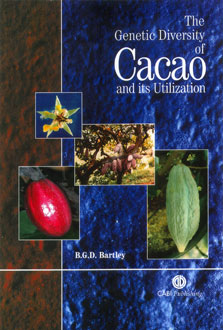Bookcase Location: MIDDLE SHELF – Permanent Collection
Bertrand Russell listed a couple motives for reading a book: either enjoyment or to boast about it. He might’ve added a 3rd: for learning…. on what to avoid reading in the future.No matter what stack of chocolate you’ve climbed up to, this still goes down a rigorous, even punishing, book. Takes the extremely long arduous slog down the Amazon — seemingly all 3 million square miles of it, paddling over its 1,000 tributaries, the most circuitous route of all… enough to give malarial headaches — thru the cartography & bio-diversity of cacáo’s formidable botanical history. Actually trekking on foot might feel quicker. A sample flavor: autogenesis of phenotypes in neotropical cacáo.
Just when it appears appropriate to question what all this is for, Bartley picks up the pace after 200 or so pages & races thru whole continents, indeed the rest of the world beyond South America, in a lightning blitz of less than a hundred pages to the end with a startling revelation: when it comes to classifying cacáo, much of the popular opinion & conventional wisdom is dubious at best, spurious at worst.
Trouble is, most of the book’s objectives are left dangling due to widespread mislabeling & mis-identification among the paucity of specimens in an industry operating without universal standards. A good case in point is the excellent if frustrating chapter,The Relationships between Populations. It lacks sufficient collections data to form definite conclusions. But even if it did have the goods, the relationships would probably be highly speculative because research centers around the world often have 2 exact same specimens referred to by different names. Or the opposite: 2 specimens that bear the same name sharing few, if any, traits.
Bartley perhaps labors in vain anyhow, given how much of the specie’s diversity lies locked in the Amazon rainforest being felled at the rate of a couple square miles every day. And very soon super-potent chocolate may be engineered in genetic labs. But he deserves glory for even undertaking what too few have dared, that is to say, untangling the thicket of cacáo’s genetic past & present, relying on both his own field research & that of the historical record gleaned from the great expeditions of Preuss, Pittier, Pound, & others; & finally bringing rigorous scientific classification to bear on it in order to clear the field of the nonsense of Criollo, Forastero, & Trinitario.
This nearly-impossible task requires resources, time, & an immense overview – all of which seem in short supply.
Cacáo is notoriously promiscuous & humans have cultivated its seeds in such a jumbled variety that it may be out of our reach to precisely unravel the genetic threads of its provenance, even using advanced modern techniques. Bartley approaches the staggering scale of this work with humility, recognizing that no single individual could hope to encompass the total range & treat the subject in its entirety by him or herself. Consequently his mission shifts to a call-to-action among cacáo researchers to do the necessary fieldwork, adhere to best practices of scientific methods, & cooperate in collating data to benefit all. (Sounds like a general prescription for humanity.)
And yet he may be thwarting his own goal by arguing for protocols so stringent among his research/academic peers that they exceed even the evidentiary chain of custody by the British intelligence service M5. What that spells for this book, however, is I-N-T-E-G-R-I-T Y.
That he falls short of completing the overall mission is simply because he’s one man, with one lifespan & limited resources.
Bartley’s work, in consultation with independent geneticists, guides significant passages of the C-spot’s Atlas section. Sadly, he died in March 2008. But it turns out there’s good news that with his passing organizations such as CocoaNet as well as Mars Corporation are now taking up the challenge to rationalize (i.e., classify), conserve, & utilize cacáo’s diversity – genetically, geographically, & organoleptically.





